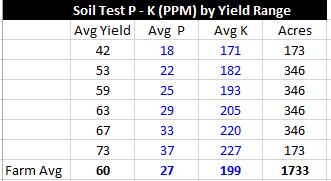January 31, 2017

Sometimes life events leave a mark for generations. The Great Depression created generations of frugal farm family survivors. Feeding a family was a challenge – holding on to a farm was almost impossible for many. The “frugal stamp” wasn’t just left on the parents but their children and many times passed on to another generation.
Did your grandmother save everything? Save leftovers - not in Tupperware but in leftover butter or other plastic food containers? Save old jeans to have material for future patches. Did your grandfather save pieces of old lumber for the next project? One of the most popular radio talk shows, hosted by Dave Ramsey, encourages being frugal to climb out of debt.
In tight economic times, it’s easy to want to take a frugal approach on crop inputs. In the November issue of CSD, an article highlighted DuPont Pioneer’s findings that many fields sampled have below optimum soil test P and K levels, with their expert calculating over $4 billion in lost revenues for growers.
The elephant in the room is the negative impact that high cash rents can have on maintaining the productivity of many farms. In most markets, the competition for land is so fierce that growers resort to penny-pinching on P and K applications. Many don’t want to leave any nutrients for the next renter if they get out-bid.
The article also highlighted the new higher-yield reality of how much has to be applied to keep up with nutrient removals. The “old” shotgun of 400 lbs. of dry fertilizer every other year can mine soil test levels quickly.

I believe the yield loss associated with being frugal is far more significant than most agronomists and growers realize. I believe that for many growers the “optimum” soil test level is even higher than university definitions of “optimum.” This chart shows one way to analyze data across a grower’s 1,700 acres of soybeans – examining the relationship between low to high yield acres and the corresponding soil test P and K levels.
If these were your yield results, what would consider your optimum soil test levels? That’s the power of your data – it can lead you to customize your approach to what is best on your farm versus a state-wide average.
There are many strategies to address the fertility needs of the crop. Strip tillage and deep banding of nutrients is a great way to compensate for low fertility fields and maximizing return for nutrient dollars invested. Irrigated sand requires that we spoon feed nutrients.
For most nutrients, feeding the crop is a combination what we apply, including manure, and what the soil supplies. We shouldn’t measure our success by whether we raised soil test levels but by our yields and cost/bushel. I believe your data will lead you to find the balance in your approach to input decisions. In corn and soybean production, you can spend yourself poor but you can’t save yourself into prosperity.
About the Author(s)
You May Also Like




